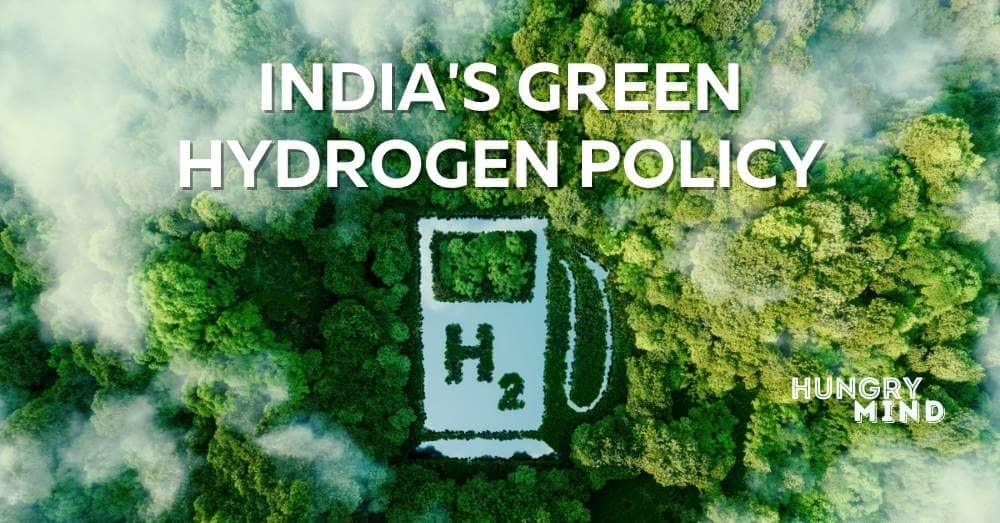India is the second-largest country in the world in terms of population and will soon be the largest, and it also has one of the highest rates of car ownership globally. To combat its growing air pollution problem, India wants to adopt a green hydrogen policy. This article will explore what India’s Green Hydrogen Policy entails and how it might benefit the clean fuel and clean energy initiative for the future of India.

India’s Green Hydrogen Policy Explained
India already has a number of pressing issues that it needs to deal with, including ageing infrastructure, high levels of poverty, and an increasing population.
The air quality in various parts of the country is deteriorating due to increasing pollution. Mainly, it is worsening through the pollution from vehicles and industries. One way that India is looking to address the polluted air is by adopting a Green Hydrogen Policy.
The idea behind India’s Green Hydrogen Policy is that it will allow for more efficient use of fossil fuels and help reduce carbon dioxide emissions from vehicles on the road.
Indian Hydrogen Fuel producers will find it easier to produce Hydrogen Fuel after India’s Green Hydrogen Policy, and this will also give Indian companies opportunities to export their hydrogen fuels overseas.
The Indian government will also provide a portal for manufacturers to apply and request information about setting up a plant that produces hydrogen fuel.
Why is India Embracing Hydrogen as a Fuel Source?
Hydrogen is an alternative fuel source that is both clean and green. Hydrogen can be used to power cars, buses, and trucks. India embraces HydrogenHydrogen as a fuel source because it wants to reduce its dependence on fossil fuels and use more green energy sources.
India has many vehicles on the road today that need clean fuel. The country has been struggling with pollution and air quality issues for some time now, and they are looking for a cleaner alternative to petrol or diesel fuels to address this issue.
The Indian government sees HydrogenHydrogen as a viable option because it can be produced using renewable energy sources like solar or wind power. The cost of producing HydrogenHydrogen from these sources is also much lower than other production methods, such as natural gas or coal-fired plants, which produce greenhouse.
What are some of the environmental benefits of Hydrogen?
Hydrogen is the most abundant element in the universe. Hydrogen is a clean fuel that produces zero emissions. It produces less than half of gasoline’s carbon dioxide, and it has zero sulfur dioxide, nitrous oxide, and particulate matter.
Hydrogen is a clean energy source that can power vehicles or generate electricity. It creates no emissions, making it an environmentally friendly option.
The Technological Challenges That Need to be Addressed for a Successful Transition to Hydrogen Fuel in India
India has one of the fastest-growing economies in the world, but it is also one of the most polluted countries. The transition to hydrogen fuel has been a challenging topic for India.
India is a country that has historically relied heavily on fossil fuels for its energy needs. However, as the country strives to become a global leader in renewable energy, it faces several challenges.
The challenges for a successful transition to complete HydrogenHydrogen as a fuel in India are two-fold: infrastructure challenges and consumer behaviour challenges. For this transition to be successful, India needs to increase its investments in renewable energy and address issues with consumer behaviour such as high prices and lack of awareness.
Challenges in India for Hydrogen Production from Methane or Electricity
Hydrogen is a clean, efficient and renewable energy source that could help India and the world transition to a low-carbon future. Hydrogen production from methane or electricity has its challenges.
The process of producing HydrogenHydrogen from methane or electricity has been researched extensively. It can be done using electrolysis, thermolysis and electrochemical reactions, but each process has its challenges. Electrolysis is the most common method used in industry today because it is more efficient and cost-effective than other methods.
Conclusion on What the Future Holds for India and its Commitment to Hydrogen Fuel and Clean Energy Sources
The research and production of hydrogen fuel and clean energy sources will occur rapidly after the India’s Green Hydrogen Policy, and we will see many improvements in the next 3-4 years. India has been committed to a cleaner environment for quite some time now, and the country is slowly but surely taking steps toward cleaner and greener energy sources.
India needs to take more steps toward cleaner and greener energy sources. This will not only help in reducing pollution but also help India become more sustainable as a nation.
ALSO READ



